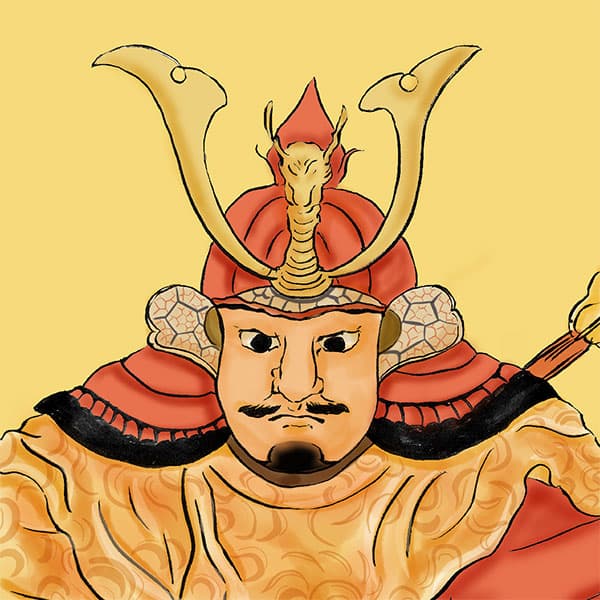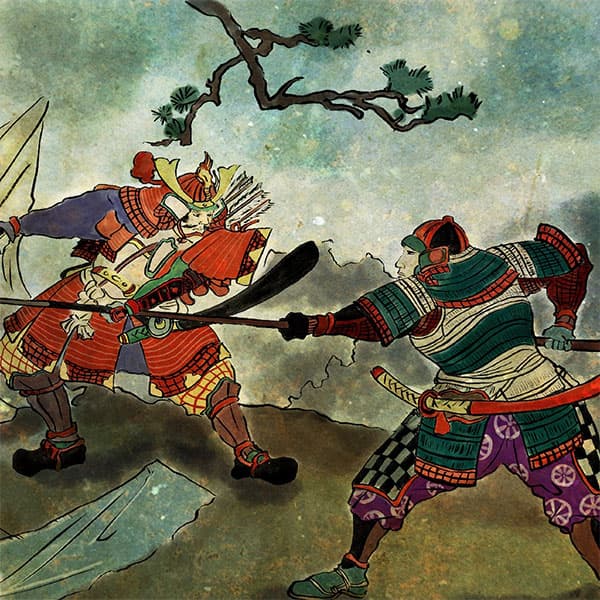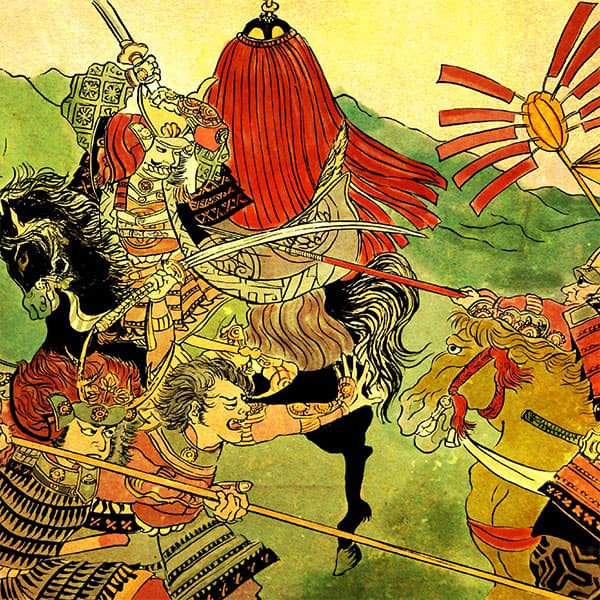Yoshimoto Imagawa (1/2)The best bowman on Kaido

Yoshimoto Imagawa
- Article category
- biography
- name
- Yoshimoto Imagawa (1519-1560)
- place of birth
- Shizuoka Prefecture
- Related castles

Sunpu Castle
- related incident
Oda Nobunaga, one of the three great heroes of the Sengoku period, first became known to the world at the Battle of Okehazama. Nobunaga defeated the invading Imagawa Yoshimoto.
Yoshimoto Imagawa was said to be the best bowman on Kaido. By stabilizing the governance of the Tokai region, he was able to compete on an equal footing with Takeda Shingen and Hojo Ujiyasu. So, what kind of person was Yoshimoto? This time, I would like to introduce Yoshimoto Imagawa.
The Imagawa family and the birth of Yoshimoto
Yoshimoto Imagawa was born in 1519 as the third son of Ujichika Imagawa, the shugo daimyo of Suruga and Totomi provinces. His childhood name was Hoshikumaru.
The Imagawa family was a branch of the Kira family, a branch of the Ashikaga shogun family of the Muromachi shogunate, but unlike other Ashikaga families, the Kira family had the right of succession to the shogunate. In addition, during the Muromachi period, there was a battle against the Ashikaga Shogun family, and as I mentioned earlier, ``If the Imperial Palace (Ashikaga Shogun family) dies out, Kira will take over, and if Kira dies out, Imagawa will take over.'' The Imagawa family was a distinguished daimyo family during the Muromachi period.
When Yoshimoto was born, his older brothers Ujiteru and Hikogoro, who share the same mother, were already the heirs of the Imagawa family. Therefore, at the age of 4, he was placed in the care of Kotokei Shoshun at Seko Zentokuji Temple.
Due to Shoshun's death in 1529, Shoshun's disciple Kyueishogiku (later Taiyuan Sessai) took over his role. Taihara Sessai's father and mother were from a family based in Suruga Province, and Sessai was the son of a senior vassal of the Imagawa family. He studied as a monk in Kyoto from an early age and is said to be a brilliant man. His father, Ujichika, entrusted Yoshimoto's upbringing to Sessai, who was said to be a genius.
Yoshimoto entered Kennin-ji Temple with Sessai and officially became a monk under Joan Ryusuke. The monk's name was changed to Sengaku Shoho. Furthermore, he deepened his knowledge by studying with Sessai at Myoshinji Temple during the Great Kyūshū period.
Imagawa family succession and the Hanakura Rebellion
The young Yoshimoto Imagawa studied as a monk at Myoshinji Temple in Kyoto, deepening his knowledge. However, his older brother Ujiteru asked him to return to Suruga Province. Immediately after Yoshimoto returned to Suruga Province in 1536, his older brother Ujiteru, the head of the Imagawa family, suddenly died. Furthermore, since the second brother Hikogoro also died on the same day as the eldest brother Ujiteru, the right to inherit the Imagawa family passed to Yoshimoto.
Like his older brothers Ujiteru and Hikogoro, Yoshimoto's mother was Jukei, so he was asked by his senior vassals to quit being a monk and return to the Imagawa family. Yoshimoto accepted this and was given an epithet by Yoshiharu Ashikaga, the Great General of the Great Conqueror, and began to call himself Yoshimoto Imagawa.
However, the Fukushima clan, a powerful vassal of the Imagawa family, opposed the succession of the head of the family, leading to confusion. Dissatisfied with Yoshimoto's succession as head of the family, the Fukushima clan rebelled by supporting Yoshimoto's older half-brother, Keitan Genhiro, as the head of the clan. This rebellion is called the Hanakura Rebellion.
The Fukushima clan went on the offensive, attacking the Imagawa mansion where Yoshimoto lived, but they had a tough time in front of Imagawa's vassals, including Taihara Sessai, who sided with Yoshimoto. In addition, when they succeeded in receiving support from the Hojo clan (Gohojo clan), the feudal lords of Suruga and Totomi provinces, Izu and Sagami provinces (present-day western Kanagawa prefecture), rebel groups such as the Fukushima clan Gradually, he became in a difficult position and was cornered by Hanakura Castle, which was his base. The castle was attacked and fell. The surviving Fukushima clan relies on the Hojo family to grow.
Yoshimoto, who succeeded the Imagawa family after quelling the opposition during the Hanakura Rebellion, became the head of the Imagawa family and established a ruling system by emphasizing the vassals who had worked to ensure Yoshimoto's succession as head of the family.
Takeda family in Kai and Hojo family in Sagami
In 1537, Yoshimoto Imagawa, who had become the head of the Imagawa family after the Hanakura Rebellion, took as his legal wife the daughter of Nobutora Takeda, a feudal lord in Kai Province (present-day Yamanashi Prefecture) who had been in conflict with his older brother Ujiteru. , formed an alliance with the Takeda clan (Koshun Alliance). However, the establishment of the Koshun Alliance ended up angering the Hojo family, who were old allies and were in a state of tension with the Takeda family, and the Imagawa family and Hojo family entered into a state of conflict. Immediately after the Hanakura Rebellion, the Imagawa family had not yet fully taken control of Suruga Province, and was internally torn apart, unable to compete with the Hojo family and forced to remain at a disadvantage for a long period of time.
While Yoshimoto continues to be under pressure from the Hojo family, he tries to find a way out of the situation. In 1545, Yoshimoto formed an alliance with Ujiyasu's enemy, the Yamauchi Uesugi family in the Kanto region, and planned to invade the Hojo clan from both sides, the Imagawa family in the west and the Yamauchi Uesugi family in the east. In response to the Yamauchi-Uesugi family, various feudal lords in the Kanto region who had been suffering from the Hojo family formed a coalition and invaded the Hojo family's territory. The Hojo family, which was in dire straits, asked the Takeda family of Kai Province to mediate, and negotiated with Yoshimoto to make peace on the condition that the territory they had stolen would be returned.
As a result, the Hojo family was able to concentrate their forces in the Kanto area, and in the Kawagoe Night Battle, they defeated the allied forces in the Kanto region. After this, the Imagawa family and the Hojo family continued to compete over land on the eastern side of Suruga Province, but as the Hojo family put more effort into managing their territory in the Kanto area, the hostile relationship gradually eased. .
In 1554, Yoshimoto's eldest son, Imagawa Ujimasa, and Hojo Ujiyasu's daughter got married. Furthermore, he formed a marriage relationship with the Takeda family and the Hojo family, forming the Kososhun Tripartite Alliance between the Imagawa family, the Takeda family, and the Hojo family. By forming an alliance, the Imagawa family in the Tokaido region, the Takeda family in the Koshin region, and the Hojo family in the Kanto region were able to manage their territories without worrying about their backs.
The Imagawa family's leap forward
At the time when Yoshimoto Imagawa was negotiating with the Hojo family of Sagami Province, he was also in charge of the neighboring country to the west, Mikawa Province (present-day eastern Aichi Prefecture). father).
The invasion that Oda Nobuhide launched in 1540 initially gave the Oda family an advantage. However, Yoshimoto received submission from Hirotada Matsudaira (father of Tokugawa Ieyasu), who was a powerful feudal lord in Nishi-Mikawa.
Nobuhide Oda, feeling a sense of crisis about the Imagawa family's advance into Mikawa, dispatched his troops to strengthen the occupation of Mikawa Province, but in 1548, the Imagawa army, led by Yoshimoto's tactician Sessai, was defeated by the Oda army. I won big.
When Hirotada Matsudaira died in 1549, Yoshimoto tried to make the Nishi-Mikawa region, which had been under the control of the Matsudaira family since their feudal lord had died, into the territory of the Imagawa family. He also attacked Mikawa Ansho Castle (present-day Anjo City, Aichi Prefecture) on the Oda side and expelled the Oda clan from Mikawa Province. As a result, the conflict with the Oda family over Mikawa Province was settled in a victory for the Imagawa family. The Matsudaira family, where Hirotada Matsudaira died, ruled by taking his eldest son Takechiyo (later Tokugawa Ieyasu) as a hostage.
In this way, Yoshimoto Imagawa, who controlled Suruga Province, Totomi Province, Mikawa Province, and Tokaido, grew to become a great daimyo. The Imagawa family, which had three kingdoms as its territory, steadily managed its territory in a stable manner, conducting land surveys and other activities.
In 1553, an additional article was added to the Imagawa Kana Catalog established by his father Ujichika Imagawa, stating that it is the Imagawa clan itself, not the Ashikaga Shogun family, who maintains the order of the current Imagawa territory. For this reason, the Muromachi Shogunate manors in Suruga and Totomi Provinces were declared abolished, and the Imagawa family as the shugo daimyo were replaced by the Imagawa family as the Sengoku daimyo.
Battle of Okehazama and its end
In the first year of Eiroku (1558), Yoshimoto handed over the headship of the family to his legitimate son Ujima and retired. From then on, the Imagawa clan's home country of Suruga and Totomi was ruled by their son Ujimasa, while Yoshimoto concentrated on suppressing and managing the new territory of Mikawa Province, planning further invasions to the west. became.
- related incident

- WriterTomoyo Hazuki(Writer)I have loved history and geography since my student days, and have enjoyed visiting historical sites, temples and shrines, and researching ancient documents. He is especially strong in medieval Japanese history and European history in world history, and has read a wide range of things, including primary sources and historical entertainment novels. There are so many favorite military commanders and castles that I can't name them, but I especially like Hisashi Matsunaga and Mitsuhide Akechi, and when it comes to castles, I like Hikone Castle and Fushimi Castle. Once you start talking about the lives of warlords and the history of castles, there's a side of you that can't stop talking about them.





